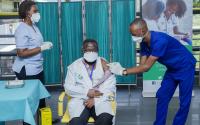[ad_1]
Table of Contents
Study notes moderate depression, anxiety in health workers during COVID
In a review of 65 studies from around the world, pooled data indicate that one in five healthcare workers (HCWs) have experienced moderate depression, anxiety, and/or post-traumatic stress disorder (PTSD) during the COVID-19 pandemic, according to a study published this week in PLOS One.
The study covered patients in 21 countries, most commonly in East Asia (46 studies, with 43 in China), the Middle East (7), and Europe (5). More than 97,000 HCWs were included, of whom 45% were nurses, 27% were physicians, 11% were other medical workers, and 1% were administration and support staff.
Across 55 studies that assessed depression, 21.7% of HCWs had moderate levels (95% confidence interval [CI], 18.3% to 25.2%), and across 57 studies that assessed anxiety, 22.1% had moderate levels (95% CI, 18.2% to 26.3%). Moderate PTSD was looked at in 9 studies, affecting 21.5% of HCWs (95% CI, 10.5% to 34.9%). Middle Eastern HCWs had the highest rates of moderate depression and anxiety (34.6% and 28.9%, respectively), which the researchers suggest could be from their high case burden.
Non-random sampling (which was employed in 60 of the studies) may have affected the results, the researchers note. The largest difference was found in anxiety: If using only randomly sampled studies, 7.9% of HCWs experienced anxiety, 14.2 percentage points lower than the total data.
Still, the researchers say, all values were higher than the pre-pandemic depression and anxiety levels that the World Health Organization reported in the general population (4.4% and 3.6%, respectively).
“The results of this review should inform action in policy and practice, to support the psychological wellbeing of health care workers,” the researchers write. “Additional research should be conducted into the factors associated with poor mental health, and future prevalence studies must adopt random sampling methods to improve the precision of estimates.”
Mar 10 PLOS One study
Low COVID-19 spread among children highlighted in 2 Spanish studies
With proper COVID-19 mitigations in place, schools may be able to open safely, according to two Clinical Infectious Diseases studies published today. Both studies took place in Barcelona province, Spain, with the first looking at 22 summer schools in Barcelona, and the second tracking 1,040 pediatric (under 16) COVID-19 cases in Catalonia.
In the summer school study, which ran from Jun 29 to Jul 31, 2020, 30 children under 15 and 9 adults were identified as index cases among 1,905 students and staff. Of 253 close contacts (median of 9 per case), 12 subsequent cases were identified, for a secondary attack rate of 0.3%. Comparatively, the general population’s secondary attack rate was 1.9%.
“These results support current policies of school opening under strict preventive measures,” the researchers write.
Mar 12 Clin Infect Dis summer school study
The second study focused its lens on whether household transmissions were more commonly from adult to child or vice versa. Of 1,040 children with COVID-19 from Jul 1 to Oct 31, 2020, 72.7% stemmed from an adult household member who had COVID-19; whereas, only 7.7% of children were confirmed index cases.
When children were the index cases, the researchers found that the secondary household attack rate was significantly lower during the school months versus the summer (21.0% vs 23.4%), and when compared with adult-transmitted cases (59.0% vs 67.6%). Overall, the study found that household viral transmission was 62.3% and that 47.2% of infected children were asymptomatic.
“Our results show that children, whether symptomatic or not, do not greatly contribute to household clusters of infection and are unlikely to be major drivers of the pandemic even when schools are open,” the researchers conclude.
Mar 12 Clin Infect Dis household study
[ad_2]
Source link












